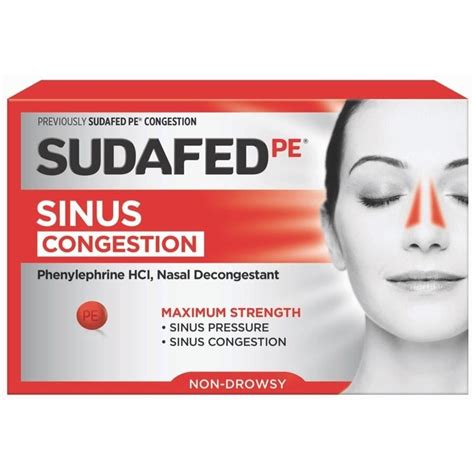Intro
Learn the proper Sudafed dosage for adults, including guidelines for congestion relief, decongestant safety, and overdose prevention, to ensure effective and responsible use of pseudoephedrine medications.
The importance of understanding medication dosages cannot be overstated, especially when it comes to over-the-counter (OTC) drugs like Sudafed. Sudafed, known generically as pseudoephedrine, is a decongestant used to relieve nasal congestion in the upper respiratory tract. It works by reducing the swelling of the blood vessels in the nose, making it easier to breathe. However, to ensure its effectiveness and safety, adults must adhere to the recommended Sudafed dosage.
For many, Sudafed has become a go-to solution for temporary relief from cold and allergy symptoms. Its ease of access and perceived safety can sometimes lead to misuse or overdosing, which can have serious health implications. Therefore, it's crucial for adults to understand the proper dosage guidelines and potential interactions with other medications. Moreover, being aware of the drug's side effects and contraindications can help prevent adverse reactions and ensure safe usage.
The appropriate use of Sudafed requires a comprehensive understanding of its effects on the body, potential drug interactions, and the specific health conditions of the individual. Adults considering the use of Sudafed should consult with a healthcare provider, especially if they have pre-existing medical conditions, are taking other medications, or have concerns about the appropriate dosage. This not only ensures the drug's efficacy but also minimizes the risk of adverse effects.
Sudafed Dosage Guidelines

The dosage of Sudafed for adults is typically standardized but can vary based on the formulation and the individual's health status. The standard dosage for immediate-release Sudafed tablets or liquid is 60 mg every 4 to 6 hours, not to exceed 240 mg in 24 hours. Extended-release forms may have different dosing instructions, usually 120 mg every 12 hours, with a maximum of 240 mg in 24 hours. It's essential to follow the package instructions or consult with a healthcare provider to determine the best dosage regimen.
Factors Influencing Dosage
Several factors can influence the appropriate dosage of Sudafed for adults, including age, weight, kidney function, and the presence of other health conditions. For example, older adults or those with kidney problems may require lower doses due to reduced drug clearance. Additionally, individuals with high blood pressure, heart disease, or those taking certain medications like MAOIs (monoamine oxidase inhibitors) should use Sudafed with caution and under medical supervision.Side Effects and Interactions

While Sudafed is generally well-tolerated, it can cause side effects, especially when not used as directed. Common side effects include insomnia, anxiety, restlessness, and increased heart rate. More severe side effects, such as hallucinations, seizures, and heart arrhythmias, can occur with overdose. Interactions with other medications, including certain antidepressants, blood pressure medications, and stimulants, can increase the risk of adverse effects.
Managing Side Effects
To manage side effects, it's crucial to adhere to the recommended dosage and consult with a healthcare provider if symptoms persist or worsen. Staying hydrated, avoiding stimulants like caffeine, and taking the medication with food can help minimize side effects. In cases where side effects are severe or unbearable, alternative decongestants or prescription medications may be recommended.Special Considerations

Pregnant or breastfeeding women should use Sudafed with caution. Although it is generally considered safe during pregnancy, high doses or prolonged use may affect fetal heart rate. Breastfeeding mothers should consult their healthcare provider, as pseudoephedrine can pass into breast milk and potentially cause irritability in infants.
Pregnancy and Breastfeeding
The decision to use Sudafed during pregnancy or breastfeeding should be made under the guidance of a healthcare provider. They can weigh the benefits against the potential risks and recommend the safest course of action. In some cases, alternative treatments for nasal congestion may be preferable.Overdose and Abuse

Sudafed overdose can lead to serious health issues, including arrhythmias, seizures, and in severe cases, coma or death. The risk of overdose is higher when Sudafed is used in combination with other stimulants or when taken in excessive quantities. Abuse of Sudafed for its stimulant effects is also a concern, particularly among individuals seeking to enhance physical or mental performance.
Preventing Overdose and Abuse
Prevention of overdose and abuse involves strict adherence to the recommended dosage, avoiding combination with other substances, and being aware of the signs of overdose, such as severe headache, vomiting, and irregular heartbeat. If an overdose is suspected, immediate medical attention is crucial.Alternatives and Complementary Therapies

For individuals who cannot use Sudafed due to side effects, interactions, or personal preference, several alternatives are available. These include other decongestants like phenylephrine, nasal sprays, and natural remedies such as steam inhalation, saline nasal irrigation, and certain herbal supplements. It's essential to discuss these options with a healthcare provider to determine the most effective and safe alternative.
Natural Remedies
Natural remedies can provide relief from nasal congestion without the potential side effects of decongestants. However, their effectiveness can vary, and some may interact with medications or have side effects of their own. Therefore, consulting with a healthcare provider before using any herbal or dietary supplements is advisable.Conclusion and Future Directions

In conclusion, understanding the proper Sudafed dosage for adults is crucial for its safe and effective use. By adhering to recommended dosages, being aware of potential side effects and interactions, and considering individual health needs, adults can manage nasal congestion while minimizing risks. As research continues to evolve, new treatments and guidelines may emerge, further enhancing our understanding of Sudafed and its role in managing respiratory health.
Final Thoughts
The key to benefiting from Sudafed lies in responsible use and a thorough understanding of its implications. By prioritizing health education and professional advice, individuals can make informed decisions about their treatment options, ensuring the best possible outcomes for their respiratory health.What is the recommended Sudafed dosage for adults?
+The standard dosage for immediate-release Sudafed tablets or liquid is 60 mg every 4 to 6 hours, not to exceed 240 mg in 24 hours.
Can I take Sudafed with other medications?
+It's generally not recommended to take Sudafed with certain medications, such as MAOIs, without consulting a healthcare provider, due to potential interactions.
Are there any natural alternatives to Sudafed?
+Yes, natural remedies like steam inhalation, saline nasal irrigation, and certain herbal supplements can provide relief from nasal congestion without the potential side effects of decongestants.
We invite you to share your thoughts and experiences with Sudafed and its alternatives in the comments below. Your insights can help others make informed decisions about their health. If you found this article helpful, please consider sharing it with others who might benefit from this information. Together, we can promote healthier living and responsible medication use.
